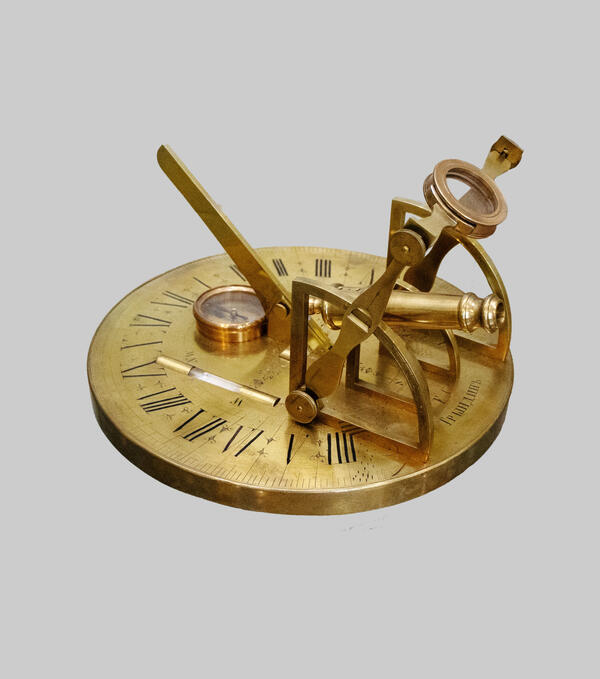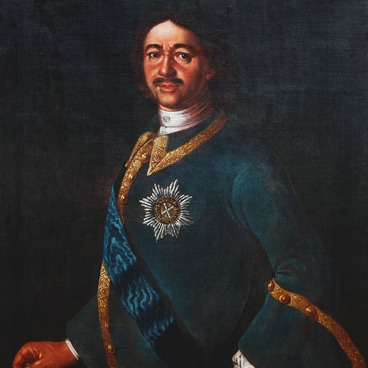Sundials fitted with a ‘noon cannon’ began to come into fashion, first in Europe and then in Russia, between the late 18th and the early 19th century. For a device like this to be used, it was installed on a pedestal situated in a sunny spot in a garden or a park. The device was fixed to a wooden stand with three screws, which allowed to set up the dial in a strictly horizontal position by using a spirit level. Same as any measuring instrument, sundials came with a case.
Sundials were used for checking the accuracy of mechanical clocks. A signal sundial combines two devices: a universal horizontal sundial itself, as well as a mechanism for sounding a signal at local true noon. The sound-producing component is called the ‘noon cannon’.
The showpiece displayed in the museum consists of a magnetic compass with a cylindrical glazed bowl and a tubular level for fixing the dial in a horizontal position, both of which are mounted on a brass disc-shaped base with an engraved inscription ‘Ye. S. Tryndin’. The base also contains a horizontal sundial with a III–XII–YII hour-line and a gnomon, the angle of which can be adjusted for latitudes within the range of 0 to 30 degrees (a gnomon is the ‘heart’ of any sundial; it is an ancient astronomical instrument that allows to determine the angular altitude of the Sun).
The mechanism of the ‘noon cannon’, which consists of a small cannon and a movable igniting lens, deserves special mention. The lens is mounted on two frames fitted with a scale for setting a precise declination angle. When all elements of the mechanism are properly adjusted for the geographic coordinates of the device and the current calendar day, the sundial can tell local solar time during daylight hours. Precisely at true noon, a focused beam of light hits the loaded cannon, causing it to fire.
For the longest time, it was believed that no historical examples of such devices had survived in Russia. However, the expert analysis conducted by Tatyana Fokina, the curator of the clock collection at the Polytechnic Museum, confirmed the authenticity of this sundial. It is a unique item with the status of a ‘limited 1-st rank monument of science and technology’, as stated in the certificate No. 1179 dated December 4, 2014.
Sundials were used for checking the accuracy of mechanical clocks. A signal sundial combines two devices: a universal horizontal sundial itself, as well as a mechanism for sounding a signal at local true noon. The sound-producing component is called the ‘noon cannon’.
The showpiece displayed in the museum consists of a magnetic compass with a cylindrical glazed bowl and a tubular level for fixing the dial in a horizontal position, both of which are mounted on a brass disc-shaped base with an engraved inscription ‘Ye. S. Tryndin’. The base also contains a horizontal sundial with a III–XII–YII hour-line and a gnomon, the angle of which can be adjusted for latitudes within the range of 0 to 30 degrees (a gnomon is the ‘heart’ of any sundial; it is an ancient astronomical instrument that allows to determine the angular altitude of the Sun).
The mechanism of the ‘noon cannon’, which consists of a small cannon and a movable igniting lens, deserves special mention. The lens is mounted on two frames fitted with a scale for setting a precise declination angle. When all elements of the mechanism are properly adjusted for the geographic coordinates of the device and the current calendar day, the sundial can tell local solar time during daylight hours. Precisely at true noon, a focused beam of light hits the loaded cannon, causing it to fire.
For the longest time, it was believed that no historical examples of such devices had survived in Russia. However, the expert analysis conducted by Tatyana Fokina, the curator of the clock collection at the Polytechnic Museum, confirmed the authenticity of this sundial. It is a unique item with the status of a ‘limited 1-st rank monument of science and technology’, as stated in the certificate No. 1179 dated December 4, 2014.



